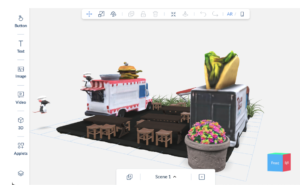How did Nashville’s Youth (Re)Imagine the Future of Global Mall with Technology?
Hannah Ziegler, 2024-25 RPW Center Graduate Student Fellow. This year’s group is exploring the theme of Emerging Technologies in Human Context: Past, Present, and Future
As part of my ongoing work with the Teens (Re-)Storying the Creek with STEM (T-ReCS) project, I have been interested in exploring ways to capitalize on the pedagogical affordances of technology in the context of critical place-based science education. Our team designed a two-week summer camp curriculum around place-based and digital storytelling centered on Mill Creek, a local waterway that flows through a large part of the diverse neighborhoods of Nashville. We worked with a cohort of middle school youth whose schools are closely located near upstream Mill Creek.

During camp, students 1) engaged in embodied creek play, 2) examined macroinvertebrates and water quality at local city parks, 3) studied local maps showing land use, stream health, and environmental justice, 4) interviewed invited guests and local residents at a plaza mall, and 5) created digital stories about the creek in the form of podcasts, zines (short for magazines), and AR (augmented reality). As youth connected with the Mill Creek watershed as a socioecological system, I wondered how technology might impact the way youth interacted with place, especially towards envisioning hopeful futures.
Specifically, we included a three-day lesson around placemaking—a process of reimagining and forming new meanings of the places in youths’ communities—through the timely and relevant case of the Global Mall. The Global Mall is a desolate shopping mall in the Antioch community that is actively undergoing redevelopment today. Thus, I was interested in how our civic design curriculum based on the Global Mall, coupled with various forms of technology, might both promote and constrain youths’ futuring and placemaking of Mill Creek.
In this civic design unit, students focused on designing and communicating their own visions for the Global Mall using maps, master plans, community interviews, and digital tools. Students spent the first two days working with paper maps to review the Nashville city government’s proposed plan for the new Global Mall, followed by envisioning their own master plan for the future mall. They not only critically examined the current government master plan, but also interviewed local professionals working in urban development and local visitors to the Global Mall to gain community feedback on their ideas.
Based on this insight, they proposed a variety of recreational facilities (e.g., arcade, drive-in theater), residential housing, medical facilities, as well as sustainable infrastructure that included green roofs or porous pavement in parking lots. In order to further visualize and communicate youths’ imagined worlds, our curriculum supported placemaking through a variety of technical tools: Polycam (photogrammetry app for the conversion of physical objects into 3D models), Genie (generative AI for 3D models), and Zapworks (web-based AR platform).
As students built and explored various 3D models of the mall, they appreciated the immersive experience that a three-dimensional rendering provided when compared to just looking at a flat image or document. Some appreciated technology’s ability to aesthetically elevate their project regardless of their artistic abilities. Youth used these digital tools to make their ideas come to life, demonstrating a sense of possibility for the future and sharing their vision with other community members, especially adults.
Despite these affordances with using 3D-design tools, we encountered some pedagogical limitations as well. Some students were frustrated with the technical troubleshooting and strongly preferred to produce hand-drawn renderings of their proposals. They also struggled to gather all of the necessary 3D assets, particularly challenged by the discrepancies between their mental images and the AI-produced 3D models. For these students, despite their excitement about designing the future Global Mall, youth felt significantly confined by the design tools that ended up inhibiting their imaginative placemaking.
Overall, we were able to observe some of the affordances of technology-mediated placemaking with middle school youth, but we also found some limitations of relying on digital tools to support students in designing the future Global Mall. Moving forward, I am interested in re-evaluating the digital tools that we chose to integrate in this civic design unit as well as making pedagogical revisions to address some of our encountered dilemmas. Are each of these technical tools necessary? What work is each tool doing for youth in their futuring and placemaking of Mill Creek? These questions will help me further examine the role of technology as youth make meaning of the past, present, and future of their own communities in critical place-based science education.
 Hannah Ziegler is a second-year PhD student in the Department of Teaching & Learning. Her research interests involve designing equitable uses of learning technologies and disrupting onto-epistemic boundaries in STEM learning environments. She is particularly interested in expanding a conceptual framework that explores justice- and human-centered use of emerging technologies to transform nature-culture relations.
Hannah Ziegler is a second-year PhD student in the Department of Teaching & Learning. Her research interests involve designing equitable uses of learning technologies and disrupting onto-epistemic boundaries in STEM learning environments. She is particularly interested in expanding a conceptual framework that explores justice- and human-centered use of emerging technologies to transform nature-culture relations.